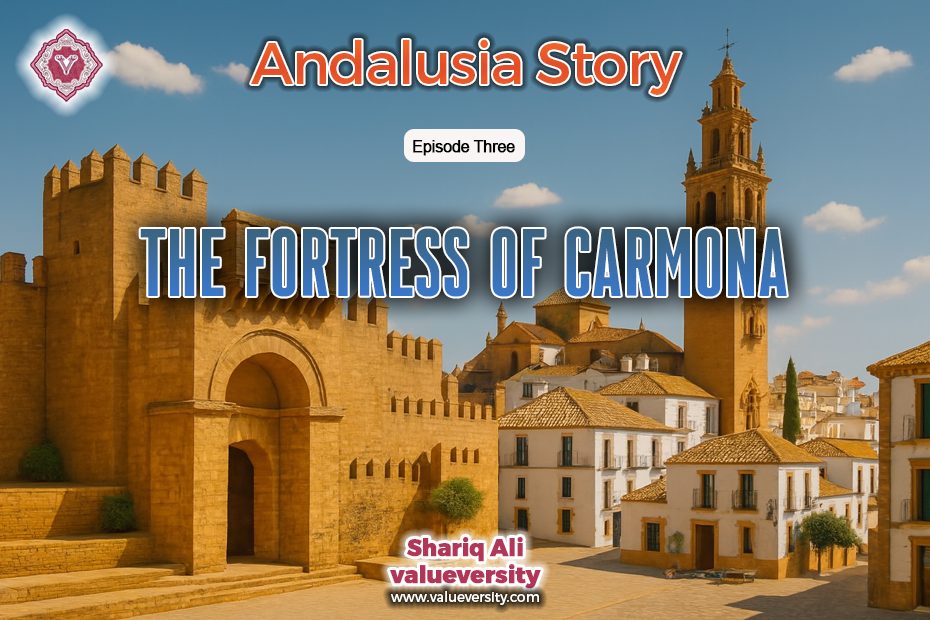The Andalusia Story – The Fortress of Carmona (Episode 3)
Shariq Ali,
Valueversity
Our coach had travelled some thirty miles from Seville and was now entering the historic Andalusian city of Carmona—known in the Muslim era as Qarmunah. We had only recently departed and were not yet fatigued from the journey, but this city was an important part of our travel itinerary.
Located about 250 meters above sea level to the northeast of Seville, Carmona offers a breathtaking panoramic view of the Vega del Corbones valley stretching as far as the eye can see. From a strategic point of view, this city has always held military importance. It served as a key military outpost during Roman, Muslim, and Christian periods alike.
Our coach came to a stop near the gates of the fortress. The surrounding area, with its whitewashed, immaculate, and elegant houses, gave the city a dignified charm. The streets were spacious and beautiful. Despite its small population, this city is considered a favourite holiday retreat for Spain’s wealthy elite.
Carmona is a city with a history spanning nearly 6,000 years, inhabited since the Neolithic era. Traces of Phoenician, Carthaginian, Roman, and later Muslim civilizations are prominently visible here. During Roman times, under the governance of Julius Caesar, Carmona—then known as Carmo—was regarded as a distinguished city, known for minting coins, strong fortifications, and urban planning.
In 711 CE, it was conquered by Tariq ibn Ziyad and later by Musa ibn Nusayr. During the golden age of Al-Andalus, the city came to be known as Qarmunah. In the Muslim era, the fortress walls were further reinforced, and grand gates like the Puerta de Sevilla were constructed.
In 1247, Ferdinand III reconquered the city and reorganized it along Christian lines. Our coach parked just outside the fortress. All the travellers disembarked in a line and entered through the grand and sturdy gate of the fortress. This magnificent entrance is an excellent example of Roman architecture, with clear and distinguishable layers of Roman, Muslim, and Christian styles.
Upon entering through the gate, we found ourselves in a vast stone-paved courtyard. The surrounding buildings formed the impression of a small town. One of these buildings had been converted into a Spanish café. We took a table and ordered tea along with some locally made crisp cookies.
The café atmosphere reflected Spanish culture—vibrant and informal. Sobremesa, the traditional post-meal conversation, was in full swing. Customers and staff chatted cheerfully and loudly, as if nothing were more important in life than conversation.
We stayed for a while, then set out to explore the fortress. Within the complex, we saw a Roman necropolis, the Santa María Church (formerly a mosque), and other archaeological remains. The church’s minaret, arches, and gardens still testify to its Islamic architectural heritage.
From the height of the fortress, the view of olive groves and the Vega del Corbones valley was profoundly moving. In the fortress and city streets, the harmonious blend of Roman, Muslim, Gothic, Renaissance, and Baroque architecture could be felt at every step.
The San Felipe Church—likely built upon the foundations of a former mosque—stood as a prime example of this architectural fusion, complete with a minaret, ablution courtyard, and domed ceiling.
The city also contains an old Jewish quarter known as San Blas, where narrow whitewashed alleyways and flower-filled balconies continue to enchant visitors.
Julius Caesar had once declared Carmona “the strongest city” and granted it the right to mint its own currency. The city has long been a hub for olive oil, wine, and grain trade.
In February, Carmona hosts an annual carnival full of music and cultural performances. Several well-known films have been shot here.
This historic city of Carmona still stands today as a living museum. Every brick, every door, and every alley whispers stories from the past.
…To be continued
